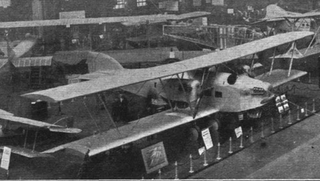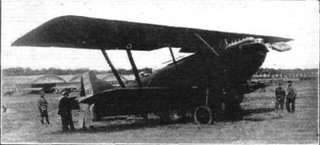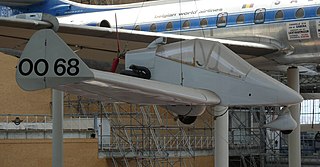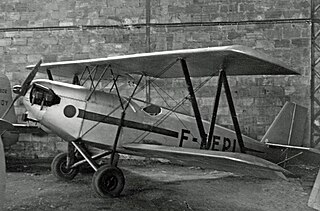
The Piel CP-30 Emeraude is an aircraft designed in France in the mid-1950s and widely built both by factories and homebuilders.
The Starck AS-27 Starcky was a racing single seat biplane of unusual wing layout with full stagger and a small gap. It was designed and built in France in the 1970s; only one was made.

The Legrand-Simon LS.60 is a single-engine, high-wing monoplane seating two side-by-side. It was built in France in the early 1960s in response to a government competition for a club trainer. It won the competition but nevertheless failed to go into production; only the prototype, which still flies, was completed.

The Coupé-Aviation JC-01 is the first of a series of very similar designs of two seat, single engine sports aircraft, amateur built from plans in France from 1976. These provided a range of engine sizes and undercarriage layouts, but total production was small.

The Potez VIII was a French training aircraft which first flew in 1920. Originally it had a very unusual vertical inline engine and a four-wheeled undercarriage, though the production version was more conventional.

The Potez XVIII was a French airliner from the early 1920s, a three-engine biplane carrying up to twelve passengers.
The Potez 26 was a single seat fighter aircraft designed and flown in France in the mid-1920s. It did not reach production.

The Potez 28 was a French aircraft designed in the 1920s to set distance records, built in both sesquiplane and monoplane versions. Only two were completed but both set several long distance records.
The Landray GL.01 is a small tandem-wing, side-by-side seat sport aircraft of the Mignet Pou-du-Ciel type. Built in the mid 1970s, the single example remains active.
The Godbille JG.1B is a French light, two seat amateur built aircraft, dating from 1989. Only one was constructed.
The Barbaro RB-50 was a small, French, high wing single engine light aircraft, amateur built in the 1960s. Only one was completed.
The Lebouder Autoplane was a French amateur built modular roadable aircraft, with a car-like component that could be separated from its aeronautical parts. The sole Autoplane flew and drove successfully in the early 1970s.
The Payen Pa.47 Plein Air or Week End was a French two seat, high wing single engine tourer, which first flew in 1949. Only one was built.
The Piel CP-40 Donald is a French homebuilt, single engine, single seat, high wing aircraft. It was first flown in the early 1950s, though the last of the three examples completed did not fly until almost forty years later.

The French tailless Pottier P.40 was the first aircraft designed by Jean Pottier. It flew in 1975.
The Potez 27 was a French reconnaissance biplane first flown in 1924. 175 were operated by the Polish Air Force, most built in Poland by PWS under licence. Others went to Romania, where they were also used as light bombers.

The Caudron C.43 was the first French five-engined aircraft, a biplane intended for passenger transport or military use and multi-engined for safety. A development of the three-engined Caudron C.39, it had one tractor configuration engine in the nose and two push-pull pairs between the wings. It was capable of carrying eight passengers but was not developed.
The Caudron Type B was a 1911 development of the earliest Caudron type, the Caudron Type A, with a nacelle style fuselage and more powerful engine. Initially an equal span biplane, it was modified into a sesquiplane.
The Lacroix-Trussant L.T.-51 Microplan was a French, low-powered, two seat amateur-built biplane. It flew just before the outbreak of World War II. After the war it was re-engined and flew until 1953.

The SCAL FB.40 was a French, side-by-side seat biplane trainer chosen in 1938 for widespread use in the Aviation Populaire programme. The Second World War prevented large scale production but at least two were restored post-war, one becoming a familiar rally participant.









